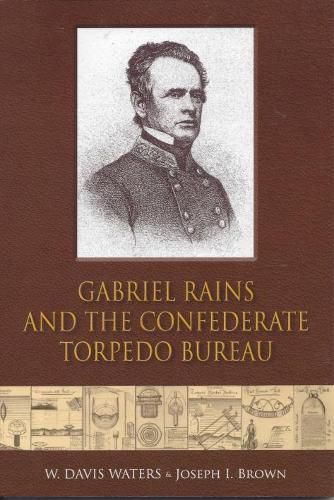Readings Newsletter
Become a Readings Member to make your shopping experience even easier.
Sign in or sign up for free!
You’re not far away from qualifying for FREE standard shipping within Australia
You’ve qualified for FREE standard shipping within Australia
The cart is loading…






Gabriel J. Rains was a Confederate Brigadier General who was more than a military officer - he was a scientist. He invented three mines: the subterra shell (land mine), the keg torpedo, and the submarine mortar battery (both naval mines). Rains had a significant military career as he introduced a new form of weaponry. To some, he is regarded as the father of modern mine warfare. Gabriel Rains and the Confederate Torpedo Bureau by W. Davis Waters and Joseph I. Brown tells his remarkable story. AUTHORS: W. Davis Waters was born in Bennettsville, South Carolina and grew up in Hampton, Virginia. In 1972, he received his MA degree at Wake Forest University and that same summer he attended the 13th Annual Seminar for Historical Administrators at Colonial Williamsburg. On the Peninsula, he learned a lot about the Civil War. Waters worked for the North Carolina Department of Cultural Resources for thirty-three years, serving as site manager at Historic Edenton and at Bennett Place. He also wrote articles for historical journals, such as Confederate Veteran, Confederate Generals (edited by William C. Davis), and The North Carolina Historical Review, including gone entitled ‘Deception Is the Art of War’: Gabriel J. Rains, Torpedo Specialist of the Confederacy. In 2005, W. Davis Waters was awarded the Order of the Long Leaf Pine, the highest civilian award bestowed by the Governor, for extraordinary services to the State of North Carolina. Although retired, Waters continues to research and write about history. He lives with his wife Denise in historic Hillsborough, North Carolina. Joseph I. Brown earned his MA degree at George Washington University. He worked for the Naval Mine Engineering Facility in Yorktown, Virginia for 31 years. While at the Weapons Station he helped design the MK25, MK52, and MK55 mines, which were used during the VietNam War in Hanoi. He also attended the Naval Mine School in Charleston, South Carolina. With his background in shipbuilding, mine warfare, and with the rich Civil War history of the Virginia Tidewater, he naturally became interested in the early history of mine warfare. Brown’s analysis of the original manuscript authored by General G. Rains, which contained numerous drawings, was a most significant and meaningful contribution to this book. 31 images, 2 maps
$9.00 standard shipping within Australia
FREE standard shipping within Australia for orders over $100.00
Express & International shipping calculated at checkout
Gabriel J. Rains was a Confederate Brigadier General who was more than a military officer - he was a scientist. He invented three mines: the subterra shell (land mine), the keg torpedo, and the submarine mortar battery (both naval mines). Rains had a significant military career as he introduced a new form of weaponry. To some, he is regarded as the father of modern mine warfare. Gabriel Rains and the Confederate Torpedo Bureau by W. Davis Waters and Joseph I. Brown tells his remarkable story. AUTHORS: W. Davis Waters was born in Bennettsville, South Carolina and grew up in Hampton, Virginia. In 1972, he received his MA degree at Wake Forest University and that same summer he attended the 13th Annual Seminar for Historical Administrators at Colonial Williamsburg. On the Peninsula, he learned a lot about the Civil War. Waters worked for the North Carolina Department of Cultural Resources for thirty-three years, serving as site manager at Historic Edenton and at Bennett Place. He also wrote articles for historical journals, such as Confederate Veteran, Confederate Generals (edited by William C. Davis), and The North Carolina Historical Review, including gone entitled ‘Deception Is the Art of War’: Gabriel J. Rains, Torpedo Specialist of the Confederacy. In 2005, W. Davis Waters was awarded the Order of the Long Leaf Pine, the highest civilian award bestowed by the Governor, for extraordinary services to the State of North Carolina. Although retired, Waters continues to research and write about history. He lives with his wife Denise in historic Hillsborough, North Carolina. Joseph I. Brown earned his MA degree at George Washington University. He worked for the Naval Mine Engineering Facility in Yorktown, Virginia for 31 years. While at the Weapons Station he helped design the MK25, MK52, and MK55 mines, which were used during the VietNam War in Hanoi. He also attended the Naval Mine School in Charleston, South Carolina. With his background in shipbuilding, mine warfare, and with the rich Civil War history of the Virginia Tidewater, he naturally became interested in the early history of mine warfare. Brown’s analysis of the original manuscript authored by General G. Rains, which contained numerous drawings, was a most significant and meaningful contribution to this book. 31 images, 2 maps